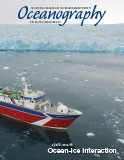Article Abstract
A satellite synthetic aperture radar (SAR) data set facilitates investigation of the two-dimensional structure of internal solitary waves (ISWs) that propagate near the Amazon River mouth. Three distinct groups of waves are identified according to their propagation direction. While cross-shelf ISW propagation has been previously documented, it is found that the majority of the waves propagate along the shelf and upstream of the North Brazilian Current (NBC). These ISWs appear in packets with interpacket separations of ~4 km, mean crest lengths of 10 km, and intersoliton separations of ~500 m. They are observed throughout the entire semidiurnal and fortnightly tidal cycles, but their origin appears to result primarily from the steady NBC, modulated by tidal currents, as it flows over shallow bottom topography. A Froude number analysis considering mode-1 nonhydrostatic linear waves propagating upstream of the NBC is found to be consistent with a regime of transcritical generation in the study region.

